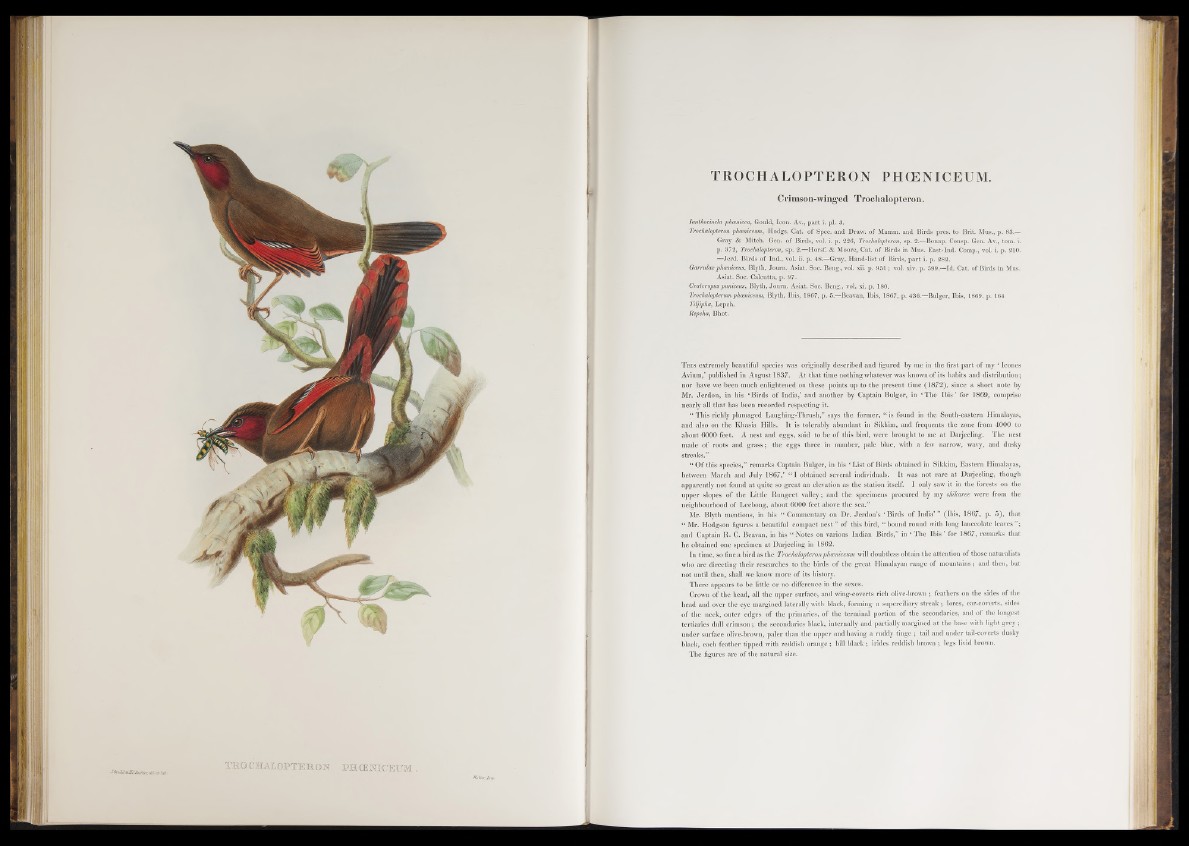
TfiO CHALOPTEROH JOmitiL&KCIiicfiter'ddsctoHih' 3PH.£ENICEOM.
TROCHALOPTERON PHCENICEUM.
Crimson-winged Trochalopteron.
Ianthocincla phcenicea, Gould, Icon. Av., part i. pi. 3.
Trochalopteron phceniceum, Hodgs. Cat. of Spec, and Draw, o f Mamm. and Birds pres, to Brit. Mus., p. 83.—
Gray & Mitch. Gen. o f Birds, vol. i. p. 226, Trochalopteron, sp. 2,—Bonap. Consp. Gen. Av., tom. i.
p. 372, Trochalopteron, sp. 2.—Horsf. & Moore, Cat. of Birds in Mus. East-Ind. Comp., vol. i. p. 210.
—Jerd. Birds o f Ind., vol. ii. p. 48.—Gray, Hand-list o f Birds, part i. p. 282.
Garrulax phceniceus, Blyth, Journ. Asiat. Soc. Beng., vol. xii. p. 951; vol. xiv. p. 599.—Id. Cat. o f Birds in Mus.
Asiat. Soc. Calcutta, p. 97.
Crater opus pmiceus, Blyth, Journ. Asiat. Soc. Beng., vol. xi. p. 180.
Trochalopterumphoeniceum, Blyth, Ibis, 1867, p. 5.—Beavan, Ibis, 1867, p. 436.—Bulger, Ibis, 1869. p. 164.
Tiljipha, Lepch.
Repcha, Bhot.
T h i s extremely beautiful species was originally described and figured by m e in the first part o f my ‘ leones
Avium,’ published in August 1837. At that time nothing whatever was known of its habits and distribution;
nor have we been much enlightened on these points up to the present time (1872), since a short note by
Mr. Jerdon, in his ‘Birds o f India,’ and another by Captain Bulger, in ‘The Ib is ’ for 1869, comprise
nearly all th at has been recorded respecting it.
“ This richly plumaged Laughing-Thrush,” says the former, “ is found in the South-eastern Himalayas,
and also on the Khasia Hills. It is tolerably abundant in Sikhim, and frequents the zone from 4000 to
about 6000 feet. A nest and eggs, said to be of this bird, were brought to me at Darjeeling. The nest
made of roots and g ras s ; the eggs three in number, pale blue, with a few narrow, wavy, and dusky
streaks.”
“ O f this species,” remarks Captain Bulger, in his ‘ List of Birds obtained in Sikkim, Eastern Himalayas,
between March and July 1867,’ “ I obtained several individuals. I t was not rare a t Darjeeling, though
apparently not found at quite so great an elevation as the station itself. I only saw it in the forests on the
upper slopes of the Little Rungeet valley; and the specimens procured by my shikaree were from the
neighbourhood of Leebong, about 6000 feet above the sea.”
Mr. Blyth mentions, in his “ Commentary on Dr. Jerdon’s ‘ Birds of India’ ” (Ibis, 1867, p. 5), that
“ Mr. Hodgson figures a beautiful compact n e st” of this bird, “ bound round with long lanceolate leaves” ;
and Captain R. C. Beavan, in his “ Notes on various Indian Birds,” in ‘ The Ibis ’ for 1867, remarks that
he obtained one specimen at Daijeeling in 1862.
In time, so fine a bird as the Trochalopteronphceniceum will doubtless obtain the attention of those naturalists
who are directing their researches to the birds of the great Himalayan range of mountains; and then, but
not until then, shall we know more of its history.
There appears to be little or no difference in the sexes.
Crown of the head, all the upper surface, and wing-coverts rich olive-brown ; feathers on the sides of the
head and over the eye margined laterally with black, forming a superciliary s tre a k ; lores, ear-coverts, sides
of the neck, outer edges of the primaries, of the terminal portion of the secondaries, and of the longest
tertiaries dull crimson; the secondaries black, internally and partially margined a t the base with light grey ;
under surface olive-brown, paler than the upper and having a ruddy tinge ; tail and under tail-coverts dusky
black, each feather tipped with reddish orange ; bill black ; irides reddish brown ; legs livid brown.
The figures are o f the natural size.